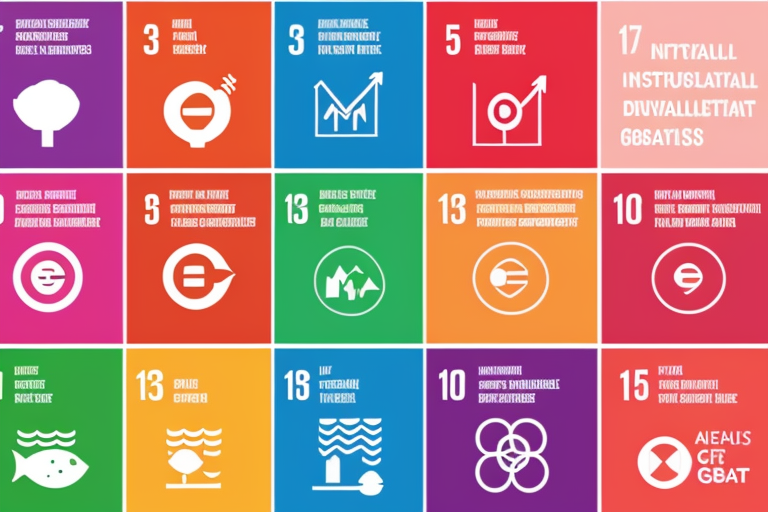Creating a Better Future for All: The Importance of the Sustainable Development Goals
As a child, I remember visiting my grandparents in a small village in India. The village lacked basic amenities like clean water, electricity, and proper healthcare. The children in the village had to walk miles to attend school, and many of them dropped out due to poverty. The stark contrast between my life in the city and the lives of these children left a lasting impression on me. It made me realize that the privileges I enjoyed were not available to everyone, and that something needed to be done to create a more equitable world.
This is where the Sustainable Development Goals (SDGs) come in. The SDGs are a set of 17 goals adopted by the United Nations General Assembly in 2015, with the aim of creating a better, sustainable future for all. The goals cover a range of issues, including poverty, hunger, health, education, gender equality, clean water and sanitation, affordable and clean energy, decent work and economic growth, industry, innovation and infrastructure, reduced inequalities, sustainable cities and communities, responsible consumption and production, climate action, life below water, life on land, peace, justice and strong institutions, and partnerships for the goals.
The SDGs are important because they recognize that global challenges require global solutions. They are a call to action for governments, businesses, civil society, and individuals to work together towards a common goal. The SDGs are also significant because they are interconnected. Achieving one goal can impact progress on others. For example, improving access to education can lead to better health outcomes, and reducing poverty can help protect the environment.
In this article, we will explore the significance of the SDGs in achieving global prosperity and sustainability. We will discuss the progress made so far in implementing the goals, the challenges and obstacles that arise when trying to achieve them, and what needs to be done to achieve the SDGs by 2030. We will also provide recommendations for ways individuals, businesses, and governments can contribute to achieving these goals, and discuss the potential impact of achieving these goals on global prosperity and sustainability.
Achieving the Sustainable Development Goals: A Case Study
The Sustainable Development Goals are an ambitious set of targets that aim to create a better, more sustainable future for all. These goals are interconnected, meaning that progress on one goal can impact progress on others. For example, reducing poverty (Goal 1) can lead to better health outcomes (Goal 3) and increased access to education (Goal 4).
However, achieving these goals is not without its challenges. Lack of funding, corrupt governance, and cultural barriers can all hinder progress towards the SDGs. In order to overcome these obstacles, it is necessary to work together and find innovative solutions.
One inspiring example of this is the story of Judge Uvanni and his son. Uvanni was a judge in a small town in a developing country. He was passionate about the SDGs and wanted to do his part to help achieve them. However, he quickly realized that he could not do it alone.
Uvanni’s son was studying abroad at a prestigious university, and he saw an opportunity to leverage his son’s education to help achieve the SDGs in their community. Together, they formed a partnership to tackle some of the biggest challenges facing their town.
One of the biggest challenges was lack of access to clean water (Goal 6). Many people in the community relied on contaminated water sources, leading to high rates of illness and disease. Uvanni and his son worked together to secure funding for a new water treatment plant, which provided clean water to the entire town.
Another challenge was lack of access to education (Goal 4). Many children in the community were unable to attend school due to financial constraints. Uvanni and his son worked together to establish a scholarship program, which provided funding for disadvantaged children to attend school.
Through their partnership, Uvanni and his son were able to make significant progress towards achieving several of the SDGs. They were able to overcome challenges that would have been impossible to tackle alone.
Their story is a powerful reminder that achieving the SDGs requires collaboration and innovation. We must work together to find creative solutions to the challenges we face. By doing so, we can create a better, more sustainable future for all.
The Progress and Promise of Sustainable Development
The Sustainable Development Goals are an ambitious set of targets that aim to create a better, more sustainable future for all. While there is still much work to be done, progress has been made towards achieving these goals. In this section, we will highlight some of the success stories of countries that have made progress towards achieving the SDGs, as well as provide statistical evidence of how far we have come in achieving these goals.
One example of a successful implementation of the SDGs is in the city of Bogotá, Colombia. The city has made significant progress towards achieving Goal 11: Sustainable Cities and Communities. Through a combination of public transportation improvements, bike lanes, and pedestrian walkways, the city has reduced traffic congestion and air pollution. Additionally, the city has invested in public spaces, such as parks and community centers, to promote social cohesion and community engagement.
Another success story comes from Rwanda, which has made significant progress towards achieving Goal 3: Good Health and Well-being. The country has implemented a comprehensive healthcare system that provides free healthcare to all citizens. This has resulted in a significant reduction in maternal and child mortality rates, as well as a decrease in the prevalence of infectious diseases such as HIV/AIDS.
These success stories are just a few examples of the progress that has been made towards achieving the SDGs. According to the United Nations, extreme poverty has been reduced by more than half since 2000, and more than 90% of children in developing regions now have access to primary education. Additionally, the global maternal mortality ratio has declined by 37% since 2000.
However, there is still much work to be done. Despite the progress that has been made, there are still millions of people living in extreme poverty, and many more who lack access to basic healthcare and education. Achieving the SDGs will require a concerted effort from individuals, businesses, and governments around the world.
One example of an individual who made a significant impact in his community is Judge Uvanni. Uvanni was a judge in a small town in Italy who was known for his dedication to justice and fairness. He worked tirelessly to ensure that everyone in his community was treated fairly, regardless of their socioeconomic status. His son followed in his footsteps and became a lawyer, continuing his father’s legacy of fighting for justice and equality.
Overcoming Challenges in Achieving the Sustainable Development Goals
The Sustainable Development Goals (SDGs) are ambitious, and achieving them requires significant effort and resources from governments, businesses, and individuals. However, there are several challenges and obstacles that arise when trying to implement the SDGs. These challenges can range from lack of funding to corrupt governance and cultural barriers.
One significant challenge is the lack of funding for implementing the SDGs. Many developing countries lack the resources to invest in sustainable development projects, and without adequate funding, progress towards achieving the SDGs can be slow. For example, in sub-Saharan Africa, only 24% of the population has access to electricity, which is a significant barrier to achieving SDG 7, which aims to ensure access to affordable, reliable, sustainable, and modern energy for all.
Another challenge is corrupt governance, which can hinder progress towards achieving the SDGs. Corruption can lead to the misallocation of resources, which can result in projects that do not align with the SDGs. For example, in Nigeria, corruption has been a significant barrier to achieving SDG 2, which aims to end hunger, achieve food security and improved nutrition, and promote sustainable agriculture. The government has been accused of diverting funds meant for agricultural development to other sectors, which has resulted in a lack of progress towards achieving SDG 2.
Cultural barriers can also be a significant obstacle to achieving the SDGs. Some cultures may not prioritize sustainable development, which can make it challenging to implement projects that align with the SDGs. For example, in some parts of the world, gender inequality is deeply ingrained in culture, which can make it challenging to achieve SDG 5, which aims to achieve gender equality and empower all women and girls.
Despite these challenges, some countries have made significant progress towards achieving the SDGs. For example, Rwanda has made remarkable progress towards achieving SDG 3, which aims to ensure healthy lives and promote well-being for all at all ages. Rwanda has implemented a community-based health insurance system that has increased access to healthcare for its citizens, resulting in a significant reduction in child and maternal mortality rates.
Another example is Costa Rica, which has made significant progress towards achieving SDG 13, which aims to take urgent action to combat climate change and its impacts. Costa Rica has implemented policies that promote renewable energy, reforestation, and sustainable agriculture, which has resulted in a significant reduction in greenhouse gas emissions.
To overcome the challenges of implementing the SDGs, countries must adopt innovative approaches that align with their unique contexts. For example, some countries have implemented public-private partnerships that leverage the resources of both sectors to achieve the SDGs. Others have implemented policies that promote transparency and accountability, which can help to reduce corruption.
Practical Steps to Achieve the Sustainable Development Goals
The Sustainable Development Goals are ambitious, but achievable. To reach them by 2030, it will require a concerted effort from individuals, businesses, and governments around the world. Here are some practical steps that can be taken to achieve the SDGs:
Individuals
As individuals, we can make a significant contribution towards achieving the SDGs. Here are some ways we can help:
-
Reduce your carbon footprint: Climate change is one of the biggest threats to global prosperity and sustainability. By reducing your carbon footprint, you can help to mitigate the effects of climate change. This can be done by using public transport, cycling or walking instead of driving, reducing energy consumption at home, and eating a plant-based diet.
-
Support sustainable businesses: By supporting businesses that are committed to sustainable practices, you can help to create demand for sustainable products and services. Look for businesses that use renewable energy, have a minimal environmental impact, and are committed to fair labor practices.
-
Volunteer: There are many organizations that are working towards achieving the SDGs. By volunteering your time, you can help to support their efforts. This can involve anything from planting trees to teaching children about sustainability.
Businesses
Businesses have a critical role to play in achieving the SDGs. Here are some ways they can contribute:
-
Adopt sustainable practices: Businesses can reduce their environmental impact by adopting sustainable practices. This can involve anything from reducing waste to using renewable energy.
-
Invest in sustainable technologies: By investing in sustainable technologies, businesses can help to create demand for these products and services. This can include anything from electric vehicles to renewable energy.
-
Partner with NGOs: Businesses can partner with NGOs to support their efforts towards achieving the SDGs. This can involve anything from providing funding to volunteering time and expertise.
Governments
Governments have a crucial role to play in achieving the SDGs. Here are some ways they can contribute:
-
Develop policies that support sustainability: Governments can develop policies that support sustainability. This can include anything from renewable energy targets to carbon pricing.
-
Invest in sustainable infrastructure: Governments can invest in sustainable infrastructure, such as public transport, renewable energy, and waste management systems.
-
Partner with businesses and NGOs: Governments can partner with businesses and NGOs to support their efforts towards achieving the SDGs. This can involve providing funding, expertise, and other resources.
The Potential Impact of Achieving the Sustainable Development Goals
Achieving the SDGs by 2030 would have a significant impact on global prosperity and sustainability. Here are some potential benefits:
-
Reduced poverty: The SDGs aim to eradicate poverty in all its forms. Achieving this goal would have a significant impact on global prosperity.
-
Improved health: The SDGs aim to improve health and well-being for all. Achieving this goal would result in a healthier, happier population.
-
Reduced inequality: The SDGs aim to reduce inequality within and among countries. Achieving this goal would result in a more equitable society.
-
Sustainable development: The SDGs aim to promote sustainable development. Achieving this goal would ensure that future generations can enjoy a healthy planet.
Conclusion
Achieving the SDGs by 2030 is an ambitious goal, but it is achievable. By taking practical steps as individuals, businesses, and governments, we can make significant progress towards these goals. The potential benefits of achieving the SDGs are enormous, and we must all work together to make them a reality.









